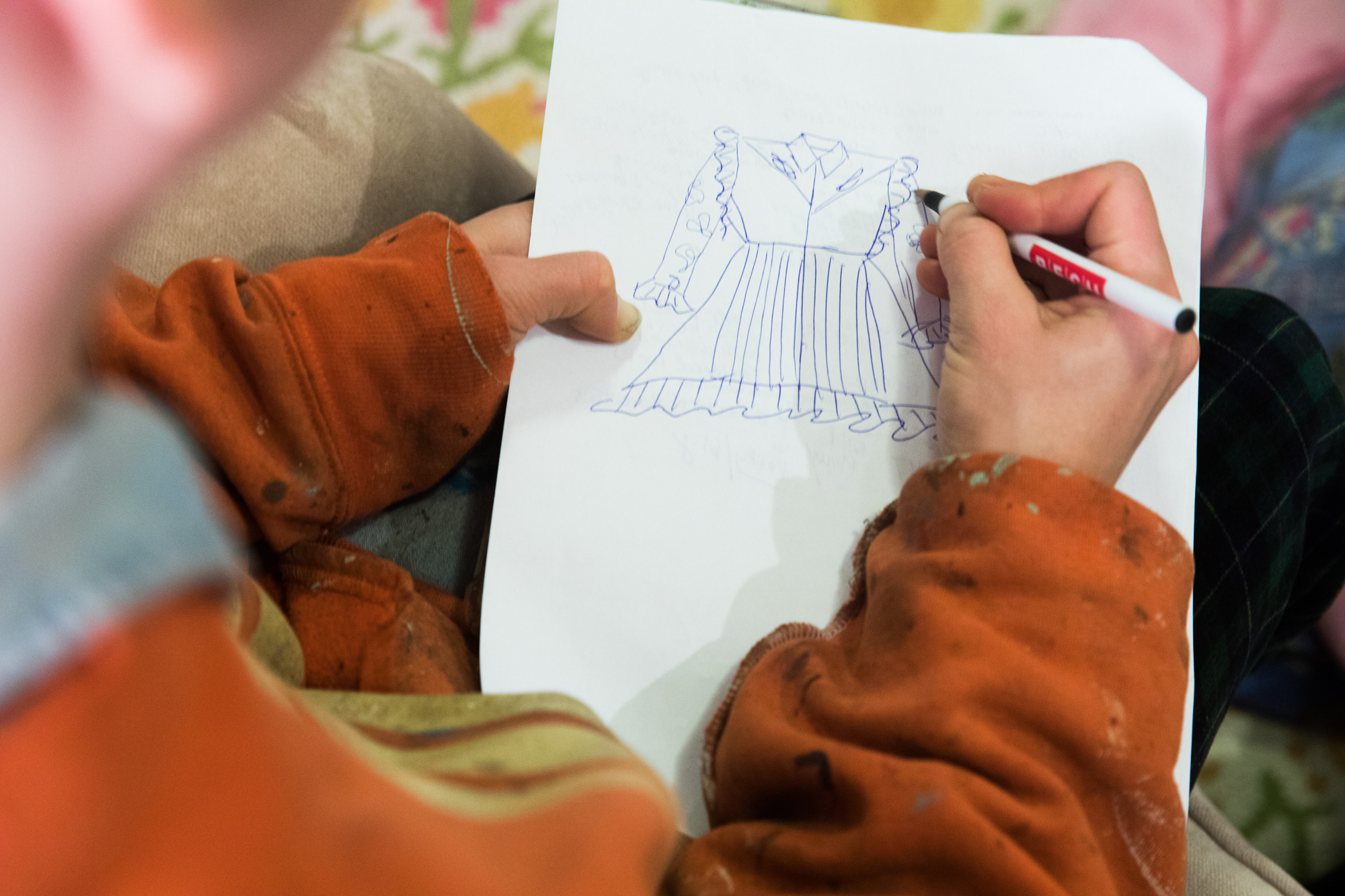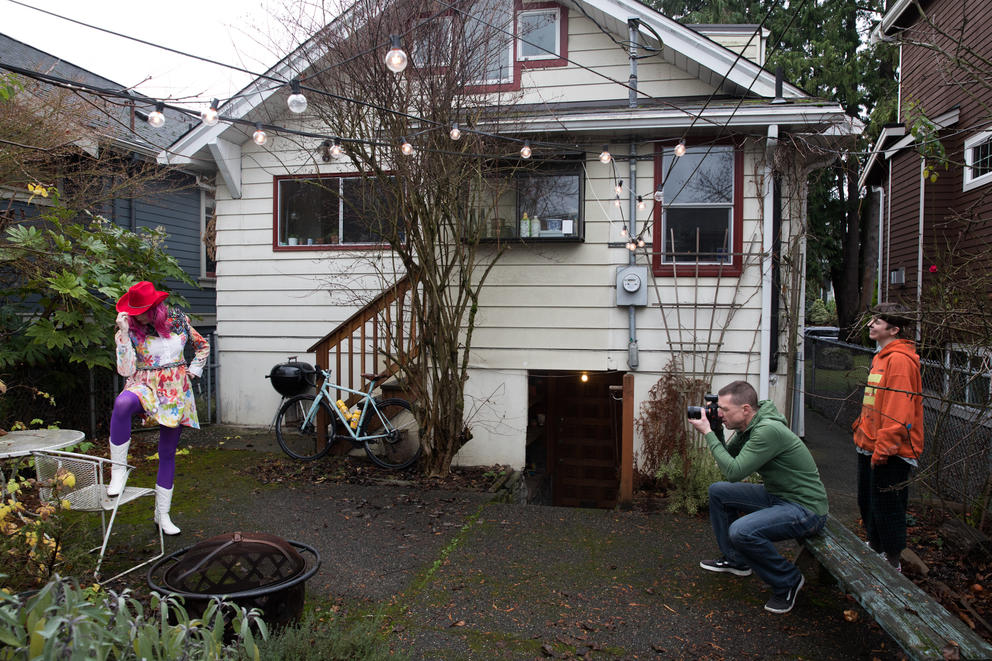Finally, Pyle shares a memory: As a kid, she had a pink nightgown with red and white hearts. She loved its frills. “I wore it all the time,” she says.
The scene, with Abbott asking questions from a plush pastel-pink chair and Pyle answering them from a nearby loveseat, has all the trappings of a therapy session. But that’s not what’s happening here.
For one, Abbott is not a trained therapist. She’s a Seattle-based artist and designer with a degree in fashion from New York’s Parsons School of Design. And she doesn’t plan to mend Pyle’s psyche — only her clothes. She’s doing what she calls Wardrobe Therapy.

For a couple of hundred dollars, Abbott helps clients dredge up deeply buried or unworn clothes they are holding on to for emotional or other reasons. Guided by the personal details she collects during these in-depth interviews, Abbott cuts up and sews the clothes into entirely new apparel.
The result often feels like the sartorial equivalent of a Picasso painting: a sleeve might return as a pocket on palazzo pants, a skirt could make a comeback as a T-shirt, and three dresses could be de- and re-constructed into a jumpsuit.
Wardrobe Therapy has hit a nerve. After launching the project roughly a year ago, advertising only through her personal Instagram page and word-of-mouth, Abbott has (re)dressed more than 30 people. Her wait list currently has fifty eager clients.
“Clothing is so easily available,” Abbott says. “You end up amassing a collection whether you want to or not. And then there's a certain point where for some people what they're sitting on is their history, or a former identity — almost like a time capsule. How do you get rid of the past?”
With the project, Abbott hopes to address some of fashion’s most toxic traits: waste, exploitation of overseas labor, body shaming and stifling conformity. While ostensibly a “zero waste” fashion initiative, Wardrobe Therapy also sits at the junction of art project, personal styling session and, yes, therapy.
“I'm just there to listen, absorb and then figure out how to solve some problems,” Abbott says.

As with therapy, trust is key. How else could you willingly let someone cut up your grandmother’s dresses, blouses and skirts, or allow a person to paint baby swans and glitter flowers on your aunt’s wedding dress?
And there are kernels of healing. Local dancer, organizer and teaching artist Angel Alviar-Langley aka ‘Moonyeka’ (who uses gender-neutral pronouns) participated in Wardrobe Therapy this year. Moonyeka has had a troubled relationship to black clothing ever since, at age 11, their father threw away their black clothes because it was supposedly “boring and basic.” By creating a new top from a black velvet dress (ironically gifted by their father) and hand-me-downs from queer performers, “[Abbott] helped me reclaim and heal parts of my own trauma in relationship to fashion,” Moonyeka wrote on Instagram.
Other times, it’s pure fun. Such as when a local artist asked Abbott to create pants with sleeves sewn onto the side so it looks like a shirt is permanently tied around their waist.
Pyle, a user-interface designer, illustrator and lead singer of local pop rock band Sundae Crush, has a personal style that falls squarely in the zanier camp. Her hair is dyed hot pink and her candy-colored backyard cottage apartment is best characterized as hipster Willy Wonka. At one point during the consultation, Pyle triumphantly holds up a multicolored faux-fur bra. The other clothes she fishes out of her closet for Wardrobe Therapy run the gamut from a 2000s H&M disco glitter dress to a thrifted vintage cowboy shirt, from a silk shirt with a baroque pattern of swords to a pink nightgown (though not the one from her youth).
With each garment reveal, Abbott gets closer to understanding Pyle’s style. “What prevents you from wearing this?” she asks repeatedly. Sometimes a stain or prickly fabric is the culprit. Abbott takes diligent notes and continues with her questionnaire: What is currently inspiring your style? Where do your clothes come from? If you go shopping, what do you gravitate toward? Is there something you’re continuously looking for but can’t find?

When the intake interview is over, Abbott takes her pencil and draws, freehand, a couple of silhouettes on the back of the paper. “I’m thinking palazzo pants with ruffles on the bottom,” she says, and, “I’m feeling very Toxic Britney Spears right now,” while drawing a glitter jumpsuit. “This could be your robot princess NYE outfit.”
Later, in her tiny, fabric-stacked Northlake studio, Abbott stretches out one of Pyle’s dresses (this one is sequined) on the paint-splattered wooden floor. A nearby mannequin awaits, nude. “This is what I already know: I want to use these sleeves and keep the shoulder pads.”
Abbot doesn’t use patterns. “I just cut and sew and see what happens,” she says while taking a giant pair of scissors to the dress and gleefully cutting out its seams, which she disposes of in a small plastic bag. When Abbott says she tries to reuse all of the garments she cuts up, she means it. The scraps she can’t reuse in the “new” clothes go into a bonus piece for her client, such as a purse, a pouch, a pair of earrings.
Though the popularity of the term “zero waste” has risen steadily in the past few years, it’s still a rather rare occurrence in the notoriously polluting and wasteful fashion industry. Nearly three-fifths of all clothing ends up in landfills or incinerators within mere years of production, according to a 2016 McKinsey & Co. report.
As awareness around climate change has increased, so has the distaste for the fashion industry’s environmental ills. Thanks, in part, to the popularity of used garment platforms like Poshmark, DePop and The RealReal, digital thrifting and secondhand clothing are on the rise. But fast fashion is still omnipresent and, if nothing changes, the fashion industry will use up a quarter of the world’s carbon budget by 2050, according to the Ellen MacArthur Foundation, a U.K.-based environmental organization.
Abbott has witnessed the rise of fast fashion and the fall of local manufacturing from a front row seat. As a kid growing up in Seattle, she would play amid stacks of fabric in the SoDo factory of Amanda Gray, a local sustainable clothing brand started by her parents in the mid-’80s. She remembers roller skating around the warehouse. The head seamstress there taught a 7-year-old Abbott how to use an industrial sewing machine. But, Abbott says, the idyllic situation came to an end after 9/11, when, she says, orders plummeted. The company eventually shuttered and both of her parents lost their jobs.
Abbott started thrift shopping, altering her own clothes. Meanwhile, overseas manufacturing surged, and since the early 2000s, the phenomenon of fast “disposable” fashion has engulfed the world. Between 2000 and 2015, global clothing production has approximately doubled, according to the Ellen MacArthur Foundation.
“It's part of the reason why I chose not to become a part of [the fashion industry] in the more traditional sense,” Abbott says. By hand-making and reusing clothes, she says, “I can stay connected to the production. It keeps me solely responsible for the impact of my work on the world. I don't want to be complicit in the enslavement of people.”

With Wardrobe Therapy, she hopes the clothing she makes reflects her client’s identities. She also hopes it helps them rethink what they already own. And revalue what’s already there.
“It feels good to be making clothing that has a purpose,” Abbott says.
By now, the mannequin is partly dressed with the rough contours of what will eventually become a glittery jumpsuit, still held together by pins.
“A more chill Britney Spears,” Pyle will later dub the piece after seeing it for the first time. In the back, a large bow — a reference to her teenage love for such adornments. (Pyle says she will wear it on New Year's Eve, when performing with her band Sundae Crush at Jupiter Bar in Belltown.) From the “baroque blouse” and pink robe, Abbot made frilly pants, a throwback to Pyle’s early clothing memories. A short dress crafted from a cowboy shirt harks back to Pyle’s Texas roots. Abbott painted the shirt with colorful flowers to cover up some stains and match the floral jacket that’s become part of the skirt.
“I just love how it matched. I also love the painterly aspect of drawing on clothing," Pyle says. “There was a lot of thought and consideration [to] who I am as a person. It’s art now.”
Get the latest in local arts and culture
This weekly newsletter brings arts news and cultural events straight to your inbox.






